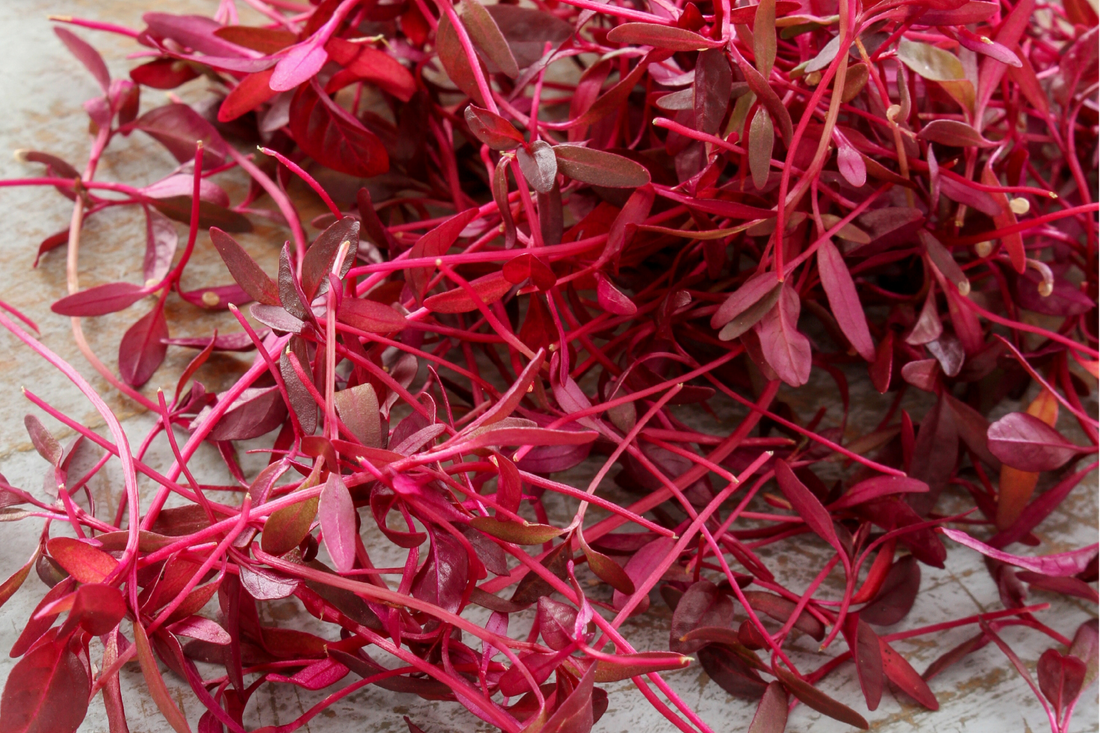
Scarlet Sparks on the Plate; the Hidden Power of Amaranth Microgreens
The moment the lid of a punnet of amaranth microgreens slips open, colour leaps out to greet the eye: fuchsia‑bright stems that seem to pulse with their own inner light. That glow is far more than a visual flourish. It is the signature of betalain pigments—chiefly amaranthin and iso‑amaranthin—whose concentration in these seedlings rivals, and in some studies exceeds, the levels found in beetroot.

Under the gaze of biochemists, amaranth appears as a warehouse in miniature. Recent metabolomic surveys show generous stores of iron, calcium and magnesium; although the absolute quantities can be lower than in mature leaves, their bio‑availability for human absorption is markedly higher, because the frantic metabolism of a week‑old seedling has not yet locked the minerals into insoluble complexes. Equally striking is its protein profile: unlike most leafy vegetables, amaranth supplies a full complement of essential amino acids, including lysine, which is typically scarce in plant foods—a quiet boon for vegan diets.

Researchers experimenting with red‑ and blue‑LED regimes discovered that by shifting the ratio of wavelengths they could almost double the seedling’s burden of phenolics and vitamin C, enhancing its ability to neutralise free radicals. The finding underscores a broader truth: within a handful of days, the plant arms itself with a rich array of natural defence molecules—antioxidants that pass directly to the diner. Betalains, once prized by Aztec priests for ritual dyes, now prove in vitro that they can scavenge reactive oxygen species and dampen inflammatory markers when paired with rutin and other flavonoids abundant in Amaranthus cruentus sprouts.

Taste, though subtler than the radish’s fiery sting, is no less memorable. The flavour of red amaranth hints at young beetroot glazed with a drop of hazelnut oil—gently earthy, faintly sweet, finished with a whisper of nuttiness. Because its character is restrained, chefs deploy the leaves with a free hand. A violet drizzle of stems across goat‑cheese mousse and blood‑orange segments amplifies the dish without bullying it. On a clear ramen broth the micro‑leaves float like edible ink strokes; in a vodka highball, they replace the familiar cranberry blush with a living streak of neon. British restaurateurs report that the seedlings resonate particularly well with citrus, fresh chèvre and roasted roots, yet they also brighten pâtisserie when scattered over a white‑chocolate tiramisù.

Service is mercifully simple. Unlike okra, the succulent stems release no unwanted mucilage, yet they snap satisfyingly between the teeth. A quick rinse and a spell on kitchen paper suffice; their lacy architecture clings to vinaigrettes but does not wilt as fast as alfalfa sprouts. Because the flavour is mild, the same box of microgreens can season savoury plates at lunch and garnish raspberry sorbet at supper with equal success.

Amaranth’s ecological credentials add a final flourish. Descended from plants that once thrived on the arid hillsides of Mesoamerica, it now yields a vibrant biomass in five to seven days with scarcely a handful of substrate and a teacup of water—an efficiency that dwarfs the resource cost of field‑grown lettuces. In terms of antioxidants per litre of irrigation, few crops on Earth are greener; however, they may appear paradoxically purple.

Aztec priests called amaranth the “grain of immortality.” Five centuries on, its micro‑form becomes a symbol of food’s future—tiny yet potent sparks that marry haute‑cuisine aesthetics with measurable nutritional benefit. When a plate needs a stroke of colour and a surge of functional value, a pinch of scarlet amaranth delivers both: a silent reminder that sometimes the most powerful stories in gastronomy begin with a seed no wider than a speck of dust.
